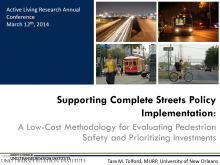We are pleased to announce an exciting new alliance between Active Living Research and GP RED to co-host and coordinate...
Supporting Complete Streets Policy Implementation: A Low-Cost Methodology for Evaluating Pedestrian Safety and Prioritizing Investments

Presentation at the 2014 Active Living Research Annual Conference.
Background and Purpose
After years of exceeding national average crash and fatality rates, New Orleans was designated as an FHWA Pedestrian Safety Focus City in 2011 (1), forcing a renewed focus on addressing this troubling and persistent problem. Meanwhile, Complete Streets policies in this area were adopted at the state, regional, and municipal levels between 2010 and 2012 (2), presenting a critical opportunity to encourage and facilitate active transportation through policy implementation. In order to equitably prioritize these investments and maximize benefits to users, implementation of Complete Streets policy needs to be linked to the region’s safety deficiencies.
Since 2006, the University of New Orleans (in partnership with the New Orleans Regional Planning Commission) has been engaged in the development of tools for evaluating crash outcomes and improving safety for non-motorized users. The purpose of this study was to synthesize these activities into a flexible, low-cost framework for conducting a comprehensive pedestrian safety analysis, providing decision-makers with the necessary data to effectively link pedestrian safety with the built environment and create pedestrian-friendly neighborhoods, a fundamental component of a Complete Streets approach.
Description
This effort addresses local and regional agencies’ need to evaluate and prioritize pedestrian crash hot spots, and to explore the factors and circumstances associated with those crashes in specific corridors, intersections, or nodes based on readily available or easily obtained data sources. Thus, the following steps were included in this analysis:
- Identification and Analysis of Crash Clusters (3)
- Pedestrian sidewalk and intersection audits (4)
- Pedestrian and bicycle counts (5)
- Analysis of area demographics, transit, and land use context
- Narrative profile of fatal and severe crash incidents within target clusters
- Recommended Interventions
The result of this analysis is a concise summary of identified shortcomings in the pedestrian environment, estimated user demand, and suggested countermeasures to improve safety for a given area. This can be used as a tool to advocate for change, to provide benchmark metrics against which to evaluate future progress, to better understand some of the complexities impacting safety outcomes, and as a tool to facilitate discussion and generate support for needed policy or infrastructure interventions.
Lessons Learned
As anticipated, this study illuminated numerous infrastructure deficiencies: many facilities need to be retrofitted to comply with the American Disabilities Act, upgrades to outdated and/or non-functional equipment, and solutions needed for long-term maintenance of infrastructure once constructed. Better understanding the conditions present in a specific node, neighborhood, city, or region that affect safety outcomes can help us to more effectively prioritize the use of limited resources for near-term interventions, as well as to holistically plan for programs and policies that will guide transportation planning in the long term.
More broadly, this study also revealed a need for systemic changes in how pedestrian accommodation is provided and prioritized, and in how crash data pertaining to non-motorized users is collected, coded, and disseminated. Overall, development of a flexible, low-cost methodology for conducting localized non-motorized safety research advances communities’ efforts to improve safety outcomes, address accessibility shortcomings, and implement new and innovative ways to better implement complete streets policies.
Conclusions and Implications
This framework for evaluating pedestrian safety, prioritizing investment, and tracking change is of potential use to many local and regional agencies, consultants, and researchers. It provides a method to efficiently guide crash analysis and mitigation, particularly in areas where access to data is constrained or non-motorized data collection programs have not yet been institutionalized.
This is especially valuable when policies have been adopted that demand such data in order to be implemented effectively, such as Complete Streets. Analysis techniques such as those described in this research can be used to 1) evaluate pedestrian conditions at the project level and identify recommended improvements, 2) prioritize investments across a jurisdiction in order to ensure that resources are applied where most needed, and 3) measure progress toward policy implementation, capturing changes in key metrics including crash totals and severity, built environment audit scores, and user volumes over time. Jurisdictions with recently adopted complete streets policies should consider incorporating multi-tool analysis frameworks such as this one in order to ensure a coordinated, data-driven approach to policy implementation.
Next Steps
The results of this study are being presented to various agencies involved in the implementation of New Orleans’ Complete Streets policies, and the researchers will continue to work with these agencies to incorporate this analysis framework in policy implementation and evaluation. Additional research is ongoing to develop a complementary analysis framework for bicyclists. Effective Complete Streets policy implementation should include coordination among stakeholders, including government agencies, developers, advocates, engineers and planning professionals, and the local community. This approach to collecting and interpreting data will be used to facilitate dialogue among these stakeholders, and ensure investments in active transportation maximize positive impacts and promote equitable outcomes for communities.
References
- FHWA Pedestrian and Bicycle Safety. Undated. http://safety.fhwa.dot.gov/ped_bike/. Accessed July 2, 2013.
- Tolford, T. Complete Streets Policy Manual. Center for Planning Excellence. 2012. http://connect.cpex.org/files/2012/08/CSmanual_FINAL.pdf. Accessed July 2, 2013.
- Fields, B., and T. Tolford. New Orleans Regional Pedestrian and Bicycle Crash Report, 2006-2008. July 2011. Regional Planning Commission for Orleans, Jefferson, Plaquemines, St. Bernard, and St. Tammany Parishes. http://transportation.uno.edu/phire-content/assets/files/PBRI_CrashReport2006-2008_FINAL.pdf. Accessed July 3, 2013.
- Renne, J.L. Auditing Neighborhoods, Streets, and Intersections for Pedestrian Safety: A Toolkit for Communities. Sept 2009. Regional Planning Commission for Orleans, Jefferson, Plaquemines, St. Bernard, and St. Tammany Parishes.Accessed July 3, 2013.
- Fields, B. Active Transportation Measurement and Benchmarking Development: New Orleans Pedestrian and Bicycle Count Report, 2010-2011. Gulf Coast Research Center for Evacuation and Transportation Resiliency. Jan 2012. Accessed July 3, 2013.
Support / Funding Source
This study was funded by the New Orleans Regional Planning Commission and Louisiana Department of Transportation and Development.
- DOWNLOAD "2014_RethinkingStreetsTrails_Tolford.pdf" PDF (1.99 MB) Presentations
STAY UP TO DATE
RECENTLY ADDED TOOLS & RESOURCES
MOVE! A BLOG ABOUT ACTIVE LIVING
The "Active Living Conference" aims to break down research and practice silos and...







